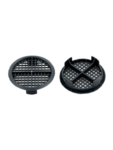Possible but unlikely as the humidity would be equalised.
John
Not quite,
Humidity is the concentration of water vapor present in the air. but how much water is dependant on the temperature of the air and water and its water vapour.
As you say the creation of condensation is the result of warm humid air coming into contact with a cooler surface. But the reason it happens is because warm air has a greater moisture carrying capacity than cooler air. and as humid cools it will drop any excess moisture it has.
Wood and other absorbent materials will also demonstrate similar characteristics.
In a stored caravan if sun shines through a window in the morning and its light falls on an internal non absorbent surface, the surface will warm a little. The air against it will also warm and thus it humidity will reduce. As warmer air rises it will begin to convect around the inside of the caravan. As it passes any absorbent surface, it will pick up some additional moisture and dry the surface a little.
As the warmed air losses its temperature it will descend, and as its now cooler it will start to get rid of the moisture it picked up a few moments ago. The excess moisture forms condensation, which will show on non absorbent surfaces, or be absorbed by the absorbent surfaces.
As the sun moves around different surfaces will sequentially warm up and then cool down as the direction of the sun changes. Just the sun on different external surfaces can cause this effect inside the caravan.
Now the changes are small, but if you have any condensation then it does mean the air humidity is just in that critical range of temperatures.
This is bigger problem when a caravan has just been put into storage after its been used, becasue during use, the caravan is usually kept warmer, thus both the air and the absorbent materials will be warmer and consequently have a greater moisture holding capacity. When the caravan is put into storage the temperatures drop, and all the moisture laden materials find they have to get rid of the excess moisture which appears as condensation.
Provided the caravan is set up to air and its fixed ventilation is not obstructed, the excess moisture will be carried away by the exchange of air with the outside.
Provided there are no water leaks that will soak parts of the caravan, after just a two or three days the average humidity of the caravan will normalise with the outside level of humidity. This is why a dehumidifier may have a benefit for a few days in a stored caravan, but longterm that benefit disappears, and it's a waste of money keeping a dehumidifier running long term.
But as described at the top there may well be some local internal transfers of humidity as the sun or other sources of heat affect parts of the caravan.


